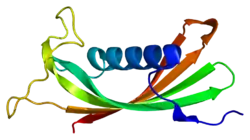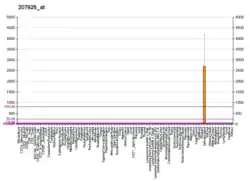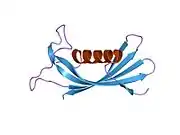CST5
Cystatin-D is a protein that in humans is encoded by the CST5 gene.[5][6]
The cystatin superfamily encompasses proteins that contain multiple cystatin-like sequences. Some of the members are active cysteine protease inhibitors, while others have lost or perhaps never acquired this inhibitory activity. There are three inhibitory families in the superfamily, including the type 1 cystatins (stefins), type 2 cystatins and the kininogens. The type 2 cystatin proteins are a class of cysteine proteinase inhibitors found in a variety of human fluids and secretions. The cystatin locus on chromosome 20 contains the majority of the type 2 cystatin genes and pseudogenes. This gene is located in the cystatin locus and encodes a protein found in saliva and tears. The encoded protein may play a protective role against proteinases present in the oral cavity.[6]
References
- GRCh38: Ensembl release 89: ENSG00000170367 - Ensembl, May 2017
- GRCm38: Ensembl release 89: ENSMUSG00000033156 - Ensembl, May 2017
- "Human PubMed Reference:". National Center for Biotechnology Information, U.S. National Library of Medicine.
- "Mouse PubMed Reference:". National Center for Biotechnology Information, U.S. National Library of Medicine.
- Freije JP, Abrahamson M, Olafsson I, Velasco G, Grubb A, Lopez-Otin C (Dec 1991). "Structure and expression of the gene encoding cystatin D, a novel human cysteine proteinase inhibitor". J Biol Chem. 266 (30): 20538–43. PMID 1939105.
- "Entrez Gene: CST5 cystatin D".
External links
Further reading
- Brown WM, Dziegielewska KM (1997). "Friends and relations of the cystatin superfamily--new members and their evolution". Protein Sci. 6 (1): 5–12. doi:10.1002/pro.5560060102. PMC 2143511. PMID 9007972.
- Saitoh E, Isemura S, Sanada K, et al. (1989). "Cystatin superfamily. Evidence that family II cystatin genes are evolutionarily related to family III cystatin genes". Biol. Chem. Hoppe-Seyler. 369 Suppl: 191–7. PMID 3202964.
- Dickinson DP, Thiesse M, Dempsey LD, Millar SJ (1993). "Genomic cloning, physical mapping, and expression of human type 2 cystatin genes". Crit. Rev. Oral Biol. Med. 4 (3–4): 573–80. doi:10.1177/10454411930040034401. PMID 7690606.
- Dickinson DP, Zhao Y, Thiesse M, Siciliano MJ (1995). "Direct mapping of seven genes encoding human type 2 cystatins to a single site located at 20p11.2". Genomics. 24 (1): 172–5. doi:10.1006/geno.1994.1595. PMID 7896273.
- Balbín M, Hall A, Grubb A, et al. (1994). "Structural and functional characterization of two allelic variants of human cystatin D sharing a characteristic inhibition spectrum against mammalian cysteine proteinases". J. Biol. Chem. 269 (37): 23156–62. PMID 8083219.
- Thiesse M, Millar SJ, Dickinson DP (1994). "The human type 2 cystatin gene family consists of eight to nine members, with at least seven genes clustered at a single locus on human chromosome 20". DNA Cell Biol. 13 (2): 97–116. doi:10.1089/dna.1994.13.97. PMID 8179826.
- Freije JP, Balbín M, Abrahamson M, et al. (1993). "Human cystatin D. cDNA cloning, characterization of the Escherichia coli expressed inhibitor, and identification of the native protein in saliva". J. Biol. Chem. 268 (21): 15737–44. PMID 8340398.
- Freije JP, Pendás AM, Velasco G, et al. (1993). "Localization of the human cystatin D gene (CST5) to chromosome 20p11.21 by in situ hybridization". Cytogenet. Cell Genet. 62 (1): 29–31. doi:10.1159/000133438. PMID 8422752.
- Balbín M, Freije JP, Abrahamson M, et al. (1993). "A sequence variation in the human cystatin D gene resulting in an amino acid (Cys/Arg) polymorphism at the protein level". Hum. Genet. 90 (6): 668–9. doi:10.1007/BF00202491. PMID 8444475. S2CID 23090315.
- Deloukas P, Matthews LH, Ashurst J, et al. (2002). "The DNA sequence and comparative analysis of human chromosome 20". Nature. 414 (6866): 865–71. doi:10.1038/414865a. PMID 11780052.
- Dickinson DP, Thiesse M, Hicks MJ (2002). "Expression of type 2 cystatin genes CST1-CST5 in adult human tissues and the developing submandibular gland". DNA Cell Biol. 21 (1): 47–65. doi:10.1089/10445490252810311. PMID 11879580.
- Strausberg RL, Feingold EA, Grouse LH, et al. (2003). "Generation and initial analysis of more than 15,000 full-length human and mouse cDNA sequences". Proc. Natl. Acad. Sci. U.S.A. 99 (26): 16899–903. doi:10.1073/pnas.242603899. PMC 139241. PMID 12477932.
- Gerhard DS, Wagner L, Feingold EA, et al. (2004). "The Status, Quality, and Expansion of the NIH Full-Length cDNA Project: The Mammalian Gene Collection (MGC)". Genome Res. 14 (10B): 2121–7. doi:10.1101/gr.2596504. PMC 528928. PMID 15489334.
- Alvarez-Fernandez M, Liang YH, Abrahamson M, Su XD (2005). "Crystal structure of human cystatin D, a cysteine peptidase inhibitor with restricted inhibition profile" (PDF). J. Biol. Chem. 280 (18): 18221–8. doi:10.1074/jbc.M411914200. PMID 15728581. S2CID 12151927.







